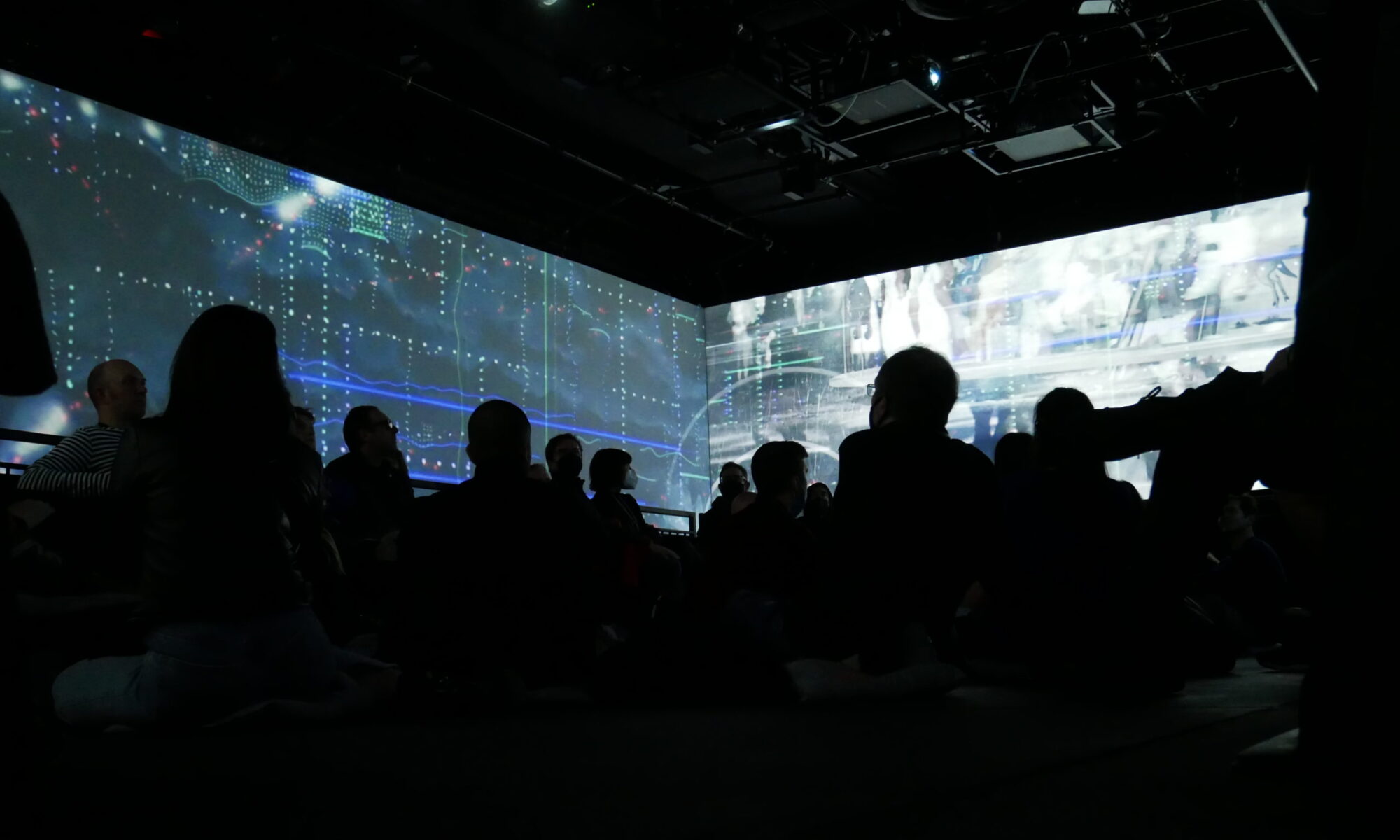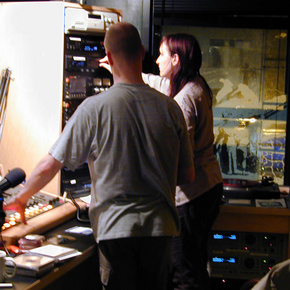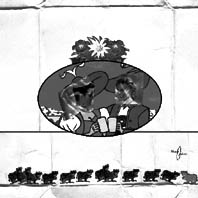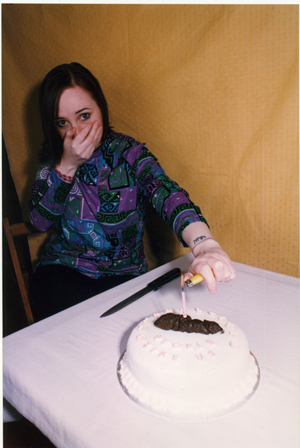Your work reminds me of two of my favourite (visual) collage artists, John Heartfield and Max Ernst. So, are there any real parallels?
Collage has always been my way of looking at the world and it was through photographic collage that I discovered working with video, film and then sound. It is the most important thing to me to be interpreted on as many levels as one can comprehend, and what better way than layering.
Heartfield, I think, deployed quite shocking imagery (shocking at the time, at any rate) with a socio-political aim in mind, to rouse an apathetic populace from their torpor and wake up to the shocking truths around them. But then, he lived in pretty interesting times – and mass communications weren’t quite as ubiquitous as they are now, so it was harder to get to the truth.
Yes, I’m aware of this work and find it very interesting. Of course I cannot fully comprehend what it must have been like to comment in his time, but understand that if you take imagery intended for one thing and then put it next to something else that you are sometimes mixing ingredients for a cocktail bomb. This is my way of working too. The extreme reactions from a mass, or even a big room of people may be far beyond what the artist ever expected. This is because the artist is immersed deeply within the foundations of his/her work and communicating with the subject matter, whereas the outsider is introduced primarily by it’s crudest or most obvious elements within their sphere of understanding. And their understanding of any symbolism may come from sensationalist or twisted sources. So if you show most people a swastika they will not only say nazi, but they will say YOU are a nazi. If you show it to an occultist or buddhist you’ll get something completely different. But then if you show an occultist or buddhist to a reactionary you’ll once again get something different! First you label, then you pin it somewhere. So you may as well do what you like.
Max Ernst was responsible for creating some astounding images in his collage books such as A Week of Kindness and The Hundred Headless Women. Here he took 19th century engravings which were potentially quite inert and innocent, yet through strong juxtapositions he made oneiric and sexually charged pictures. And there was a double-whammy effect to that, because he used imagery familiar to his own immediate generation, thus intending to unsettle the cosy belief-systems of Mum and Dad. For instance, consider your own use of easy-listening LPs. Aren’t these like ‘Mum and Dad’ music? And the found voices, especially from Radio 4 – intended to be reassuring and cosy, you make them into something quite different.
Yes, very nice. What’s the best way to provoke? With what we all have in common. Upbringing, popular culture, sex, religion. All are bigger than the individual and all are things we struggle with. Max Ernst knew the power of digging deeper into the hole of taboos, the unspoken. He knew that you have to seduce with the familiar in order to open people up. Otherwise you alienate people before you’ve got their foot in the door! That’s my belief too. Although I don’t altogether know what to do with people once they’re IN the door I know that you have to find a common source of interest. Yes, my use of “Mum and Dad” and the other familiar cosy things is definitely to do with seducing the listener enough to pay attention. It is also a bit of a zen way of working. To attain the awe of the audience is half the battle. You can do by confusion or provocation amongst other things.
Another essay question, a bit more provocative. I’m not against you, but let’s probe this area a bit… How effective can this form of subversion be; what is the intended audience; can it really work on them? For instance, ever since I was an art student onwards I’ve come across dozens of examples of my peers taking great delight in sneering at popular imagery of the past. I’m a big comics fan, and have met loads of civilians who sneer at the creaky old adverts from the 1950s. Actually some of them are downright weird! Isn’t this just a kind of lazy smugness on our part? The underlying implication is that ‘we’ somehow know better than ‘they’ did in the past, we are more emancipated than the previous generation. I feel sure this could translate into ‘People Like Us Hate People Like You’. It must be something you have thought about….
I understand what you’re saying. I see a certain arrogance in taking the mickey out of things and it’s often a case of choosing easy targets for an easy audience. Or rather, it’s art for the establishment. You even get established experimental! We are making work for our own kind, aren’t we? Whether that be our own tiny circle of friends or our own massive generation. No one makes work for those that they think wouldn’t understand or couldn’t mirror unless they are trying to provoke a reaction. I believe that humour is one of the few areas of life where you should be allowed to do exactly what you want, nothing is sacred. That is maybe why it is so attractive to me. However, just because this is the case it doesn’t mean that I don’t respect the content that I am manipulating. When I play with BBC voices and radio callers I am to an extent paying homage to the broadcast medium. I don’t hate these people, I can’t work with that which I don’t feel warm with. I owe them a great deal for inspiring my work! Back to what the intended audience may be – so long as you feel that within yourself you’re moving and experiencing new things and people seem to be translating that then the target audience would be any inquisitive person on the planet. For readers who don’t know my work – my previous album (from 1997) was called People Like Us “Hate People Like You”. With a name like People Like Us, and being someone who makes titles and music out of puns, it was inevitable! My material is very crude at times and yes, primitive. I wasn’t really making a statement that I hate “people”, I don’t any more than I love them! If I was then I was sending myself up to a certain extent. I then named the Remix CD “Hate People Like Us” because it contains remixes of “Hate People Like You” and contains people like “us”! Also, on a more personal and subconscious level it could be said that such if you engage in a duality situation of being part of any group of people, in any box, you eventually turn on your own kind and yourself. Having said that, I am an elitist. Or rather, I don’t see that democracy makes good art.
Another instance, again an art student thing, oh the number of people who used Ronald Reagan movie posters from his Hollywood past in order to make some ‘ironic’ point about his being a war-mongering President! At least, that’s how we young anti-Nuclear weapons protesters liked to see it…simply pick a picture of Reagan dressed as a cowboy from some Western potboiler, stick a nuclear explosion behind it and voila! Instant social commentary…I think what I disliked here was the laziness, and commonplace use of a banal idea. (You’re better than that though)
Yes, we all start with the most obvious thought but hopefully with a little persistence can start digging deeper for more obscure angles to take on any situation. Of course there is irony in my work, but a lot of the time I am a victim of my own irony, that is why I continue to work with such a thread because it moves, and where there is movement there are ideas. Many a time I’ve liked something because it is bad, because it lacks taste… because it makes me laugh, whatever. But any artist will say that once they have sat with that material for a week and ploughed over and through it, eaten it and regurgitated it, they no longer find the initial attraction appeals at all, let alone find it remotely hilarious. But that makes it all the more funny! No wonder not many artists work with humour! So you may well take Clinton holding a book and stick a woman on the cover with her tits out, and that’s a start. But then the test is whether to leave it at that or immerse yourself in every possible angle of what you could do to it after that. Someone might find a crude statement banal, but it is only because it is such statements that get picked up on and used so many times. I find questions far more interesting than answers. I don’t think I have any particular statement to make in my work. If I want to talk, I’ll do interviews. The music should speak for itself, and besides, I’m a lousy tour guide. Most people would sooner go around the Ronald Reagan Roundabout har-harring forever than actually choosing a junction and buggering off. And art college is the most uninspiring place on earth to make art. I used to have to go home before I could do anything. A final instance, how much tweaking do you really have to do to your found sources to achieve the desired effect? I don’t follow the same method for each piece. It might be easier to work that way, with a formular, but I do try to see every new piece as a blank page. Time-wise, the spoken word manipulations take the longest because the timing and editing has to be so precise for the slapstick to work. But for other pieces it is simply a case of finding 2 elements that work – more like being a DJ than a composer.
I recently snagged a copy of the first Negativland LP. For the cover they’ve clipped and pasted old adverts from a 1950s family magazine, with absolutely no intervention or collage whatsoever. In the context of the record, the pictures are satires of themselves already – without their having to call attention to it. Each cover was done by hand, each different.
That is a good album. Very naive – that’s a compliment by the way. Exploring rather than knowing. My first album was done meticulously too – 100 LPs – a split release with Abraxas. We got the artwork done on nice paper at the photocopy shop, when we got the labels done I had to cut all the holes out myself. But this was all because we had no idea how to do it any other way. Maybe that was part of the case with Mark Hosler and co too.
Something a bit easier. Do you value humour above shock or surrealism?
I’d say that humour and shock are reactions to surrealism. I value the surrealist viewpoint above just about anything that I could possibly think of. Despite all the aural tripwires and booby-traps, there seems to be a real fun, user-friendly element to the work – and lots of lush surfaces. Though you get compared to John Oswald and Negativland a lot, those guys seem quite severe in comparison. And they’re didactic – ‘I’m telling us something, and it’s for your own good, understand?’ I use techniques, found sound and humour, as do John Oswald and Negativland for sure. Shove me in that box. My work is more consistently idiotic and pointless. Of course I have strong opinions about copyright and materialistic/spiritual issues, but they aren’t really the message. Hopefully when you look into my work you see what you are as much as what I am. I don’t want to tell stories that are unambiguous because then the story would end there. Ambiguity is my goal, yes! Another thing – I am very British, and dare I say, female. Although I don’t think being female makes much difference apart from the occasional bout of positive discrimination. A lot of people think that PLU is a bunch of blokes, which is great!
Are the, erm, narrative ideas more important than the sound-world qualities?
The narrative is treated like music if possible. Rhythms and harmonies within the words are extended and played upon, although with more detail. You have to be more anal about the text! I LOVE the disorienting effects you create, and they’re not just through sudden edits and juxtaposition. The sound makes me feel like I’m dreaming, the internal logic is delightfully inexplicable. That’s what I want. I want people to surf statically on my sounds, tripping over but never moving forward! I love to work with radio because it is a passive medium in a way. You just switch on and listen. You switch off and listen! It is very funny to play people my radio cut ups and watch their eyes glaze over as if they are listening to a normal unadulterated broadcast. And then their eyes light up when they suddenly hear all the words turn into the most confusing sentences and slurring and looping. It’s such a strong medium, so hypnotic. I would like to do the same with TV at some point but TV is less subtle, and the ears are more sensitive than the eyes because you can’t look away.
The only record that comes close in the same way is Revolutionary Pekinese Opera by Ground-Zero. In that case I feel fairly sure in assuming that Otomo simply likes stringing strange sounds together, above any narrative content. You, on the other hand, seem a bit more involved with the content. Is that true?
Well, having just said that I treat words as music, I am not so abstract in my working methods. One must get involved further or it would be all surface and you could just use anything. Having said that, Don Joyce said to me that one source is as good as the next, and I do understand what he means. Yes, I love the mundane, the boring, morose. Or rather I love the way that it invokes movement in the rebellious. I am inspired to change that which stifles me. But at the same time I appreciate the comfort that a late night radio broadcast brings and tune in myself, but partly because it is funny hearing people talking about things that really aren’t very interesting at all. I can buy into comfort and security but at the same time cannot feel I can trust such a thing because it makes you shut down. Then you’re open wide.
How does your work differ when performed in a live context? How do people react? Has anyone ever been shocked, provoked?
I used to DJ – although I felt that it was “live” because of the extent of the collage making that was taking place – and also I felt that just because you use a DJ’s tools you may not fit into the DJ definition, whatever that may be. But I grew tired of using record decks and CD players because I wanted to be presenting sounds that had been manipulated further by myself. Now I use CD-Rs and MiniDiscs of my own work and take apart my compositions and remix myself in a live situation. Video is a big part of my work too – I use found film footage transferred to video and edit it much in the way that I do with sound collage. The video provides that audio and visual accompaniment and sometimes dialogue for my performances. I’d say I’ve been shocked/provoked and so have the audiences. More so when I’ve DJ-ed because there is more of an expectation that if you DJ that you are basically a slave to the audience and are answerable to their every whim. Disgusting! Certainly when I’ve DJ-ed people have queued up to complain and pick verbal fights with me, people have been thrown out for getting so aggressive. In turn I get provoked and just do more – feeling justified for annoying them! This is when I’ve played in the “wrong” bars, etc. It could be said that these are exactly the right places to play difficult music. These days I make sure people know I am not going to “DJ”. I tell the organisers that I’m going to do a live set, and generally won’t do it unless it’s in a cinema or seated type of space, or that I know it is an art venue rather than techno (ie tech-no-notice) environment. I’ve had enough of that. But I’m still searching for the best way to work in a live situation. I love to play live with other people and have enjoyed many collaborations with my friends in America such as The Jet Black Hair People and Wobbly. Improvising with them has produced the most amazing moments and real intuitive working. There has been nothing like it. But at the same time there is a part of me that likes to work alone, but that’s more of a studio thing.
Hate People Like Us seems a very sympatico collaboration. Are all the remixers friends, people you’ve worked with? How long did it take to put together? Speaking of friends and collaborators, has your worked evolved in isolation, or are there any personal influences?
I chose the artists for the CD because I think remix projects are often rather boring and the same people get chosen all of the time. Most of the people that I chose are friends or people who have shown enthusiasm. I’m proud and flattered that this has come together, even though the project took two and a half years. It drove us mad. I started to wonder at times if project was ever going to end, and in fact the 2x CD was pressed but is not going to be repressed or sold by Staalplaat. However, the Soleilmoon 1xCD is doing well and we’ve got lots of good publicity for it, am going to be Band of the Week in “Alternative Press” shortly, ha! My work is always a reflection of the people that I’ve seen and the places I’ve been to. But I generally am alone when I make the music. So it’s both.
“Shitcake”- didn’t realise until I saw the title that there was a turd on the birthday cake! Doesn’t this image sum up something about your work, the thrilling combination of beauty with ugliness, often in the same bite of the cake. Some of your droney loopings are as evocative and powerful as any record by say Amon Duul or Popol Vuh, yet you’re frequently undercutting it with trash, vulgarity and weird foreign elements.
That’s funny, you blocked it out! A number of people didn’t notice the natural additive at first, actually. So do you want to know if it’s a real turd? Believe it or not I had a vision for that CD cover! In Spring 1998 I had an operation after breaking my leg. When I came round I was holding a plastic bag with my metal screws and a long pole in it and thought of a satin cushion with a shit on it surrounded by dry ice. Modified the idea slightly, bought the cake, decorated it and then acquired the aforementioned stool at great cost. You’re spot on about the combination idea. Only with bright light can you see shadows. It is what lies on the periphery that appeals to me, I’ve never been interested in the main stream, even if it’s good. To embrace the polarity and extremes of life may bring hope of understanding this so that it is not so extreme any more. But also, I’d say that the shit on a cake is a defiant two fingers up, just for the hell of it.
Many thanks to Ed Pinsent for doing this interview, we strongly urge you to buy the magazine.




